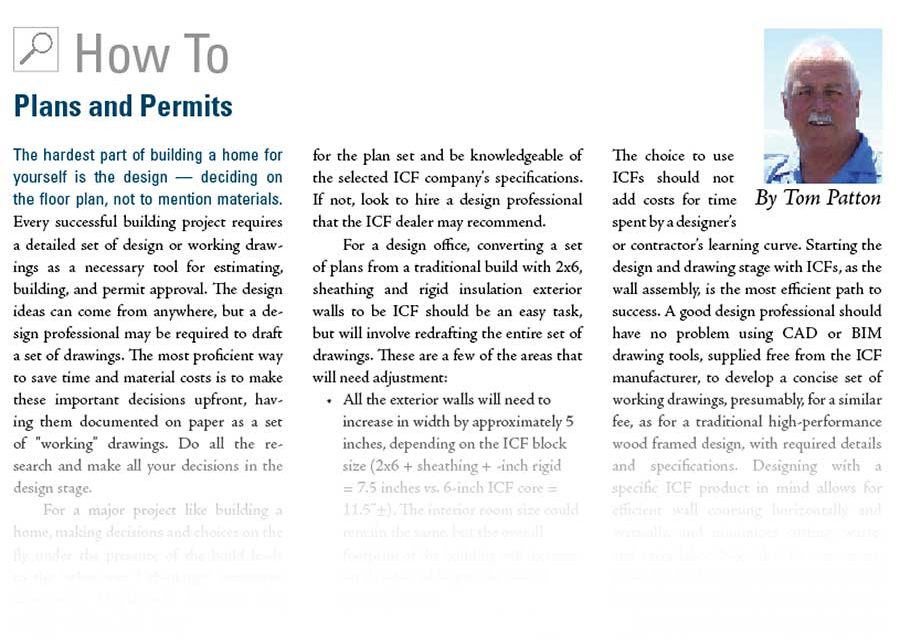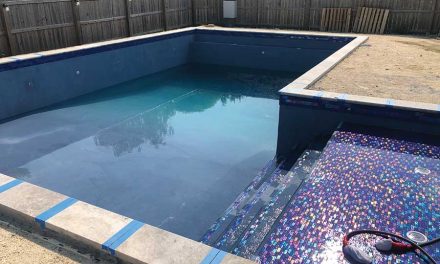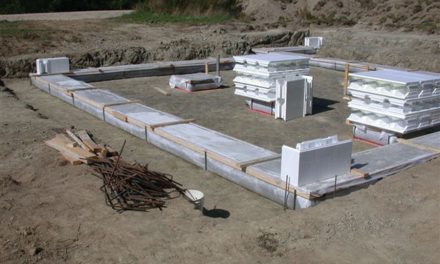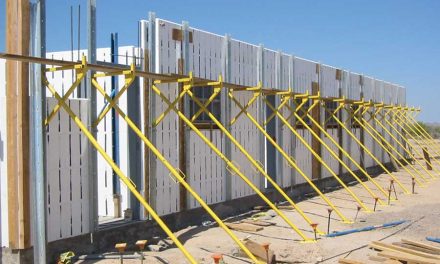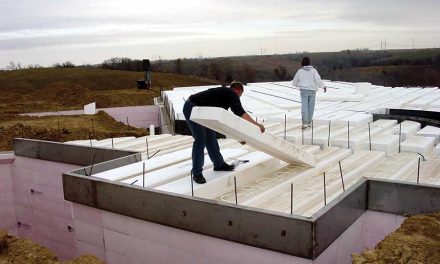The hardest part of building a home for yourself is the design — deciding on the floor plan, not to mention materials. Every successful building project requires a detailed set of design or working drawings as a necessary tool for estimating, building, and permit approval. The design ideas can come from anywhere, but a design professional may be required to draft
a set of drawings. The most proficient way to save time and material costs is to make these important decisions upfront, having them documented on paper as a set of “working” drawings. Do all the research and make all your decisions in the design stage.
For a major project like building a home, making decisions and choices on the fly under the pressure of the build leads to the “what was I thinking?” statement afterwards. Unplanned decisions also quickly add to lead times, plus material and labor cost overruns. Every build will have a few pressure points, but a well-thought out design and set of construction documents will minimize on-site pressure points and ultimately save time and money. In addition, a quality set of construction documents acts as a legal document to protect the owner and ensure they get the building and vision described in those drawings.
There are numerous home design companies that sell stock design plans for either traditional or ICF construction. Selecting a design from one of these catalogues can be a great first step. Stock plan companies will make design changes for an added cost. You may need to hire a design professional in your area to ensure the plans will meet the local code requirements. If a stock plan company does not supply ICF drawings, then that specific plan layout may be off-limits for another company to re-design with ICFs, due to copyright rules. A stock plan company should advertise ICF design as an option for the plan set and be knowledgeable of the selected ICF company’s specifications. If not, look to hire a design professional that the ICF dealer may recommend.
For a design office, converting a set of plans from a traditional build with 2×6, sheathing and rigid insulation exterior walls to be ICF should be an easy task, but will involve redrafting the entire set of drawings. These are a few of the areas that will need adjustment:
- All the exterior walls will need to increase in width by approximately 5 inches, depending on the ICF block size (2×6 + sheathing + -inch rigid = 7.5 inches vs. 6-inch ICF core = 11.5”±). The interior room size could remain the same, but the overall footprint of the building will increase on all sides, adding to the overall square footage.
- Similarly, any interior ICF walls, such as the wall between a garage and the house will impact adjacent interior rooms and/or garage sizes.
- Main plumbing drains are recommended to be relocated from an exterior wall (removed from the concrete core). These will require furring spaces or relocation.
- Windows, door frames, and sills need to be extended for the new wall width and the rough openings enlarged to accommodate the buck system.
- Detailing for floor and roof attachments.
- Basement walls require reinforcing, waterproofing, and gypsum board covering the EPS.
- Re-design of the HVAC system from high-performance and airtight ICF wall assemblies.
Contracting a design professional allows for the freedom of design and guidance to a well-organized and efficient layout. Selecting a design professional with proven ICF experience is the best solution. The choice to use ICFs should not add costs for time spent by a designer’s or contractor’s learning curve. Starting the design and drawing stage with ICFs, as the wall assembly, is the most efficient path to success. A good design professional should have no problem using CAD or BIM drawing tools, supplied free from the ICF manufacturer, to develop a concise set of working drawings, presumably, for a similar fee, as for a traditional high-performance wood framed design, with required details and specifications. Designing with a specific ICF product in mind allows for efficient wall coursing horizontally and vertically, and minimizes cutting, waste, and extra labor. Note that in some areas, plans for building permits may require a stamp from a certified design professional, architect, or engineer. At the very beginning of the design process, confirm with the building department what is required in your area. If necessary, connect your design professional with the ICF manufacturer’s website and/or support services to ensure the ICF design is incorporated efficiently and correctly.
A well-detailed set of drawings with product specifications provides more accurate information for material estimates, eliminating guesswork on materials and achieving better bids from suppliers and subcontractors. Less confusion in all the processes, from estimating, permit approval, and on-site construction, will lead to an overall better, more efficient experience. Plans with inadequate information leaves opportunities for guesswork, change orders, cost overruns, and project delays.
In moving forward with the plans, you need to assess how many sets of drawings are required. Check with your building department to see how many sets of permit application drawings are required (typically 2 to 5) or if electronic files are acceptable. You should have one set that is called the Master set (stamped as approved by the building department), one set that is on-site and a couple of sets for building supply stores and one for subcontractors to bid on and return. Generally, 5 to 6 sets are a minimum. Keep your Master set protected, preferably indoors, and keep track of all changes, revisions to dimensions, etc. Any plan used on-site must be the same as the Master. Any revisions will need to be transferred to all sets of drawings. In addition to the working drawing sets, the builder is recommended to keep an up-to-date daily logbook of events, changes, issues, orders, etc.
Applying for a building permit for an ICF building should be a smooth process as ICFs are an approved building material and covered in detail, with specific applicability limitations, in the International Residential Code (IRC Chapter 608). Using an ICF brand that has product Code Compliance approval with an Evaluation Report (ESR, CCRR) is extremely beneficial (check the ICF manufacturer’s website). Products without an approved compliance evaluation will require special inspections, possibly more engineering, and additional costs. The IRC has reinforcement tables for below and above wall assemblies, lintel tables, and specifications. Also, major ICF manufacturers have prescriptive engineering tables that may be utilized by the designer or building department. To expedite building permit approval, the working drawings should have on them the specifications of the ICF to be used — refer to the ICC product report and reinforcement tables for below grade and above grade walls, plus lintel rebar tables. If required, utilize the ICF manufacturer’s support network to assist in design applications and details. The ICF support network will also assist on any issues with building departments related to product approval and code evaluation reports.
One issue building with ICFs in certain areas is that the building department/inspector may be unfamiliar with ICFs. Providing more information about the ICF on the drawings, accompanied by references to the IRC building code, and even a copy of the ICF manufacturer’s product code evaluation report, will expedite the process. This may be a learning experience for everyone involved, but the ICF manufacturers are available for support. The biggest no-no is to apply for a permit with traditional construction plans, then have the inspector come to the site and find an ICF wall assembly. This initiates a stop work order, which may end up being very costly and time consuming.
Always check with the building department about what they will require for on site inspections — footing, below- and above-grade wall reinforcement — prior to concrete placement. Another expensive experience (requiring x-rays and engineers reports) is not having the walls approved (if required) prior to concrete placement. Be prepared, simply by asking the building department upfront, on their inspection requirements. Some areas are not able to inspect the walls or may not have an inspector available for inspection at the exact time required. For some builds, because of the speed of construction with an ICF, the footing inspection could be one day, and the wall rebar inspection could be required the very next day. Check to see if taking a picture of the reinforcement in the walls prior to concrete placement will meet with the inspector’s approval, or have a design professional available to approve the reinforcement installation in the walls. Anticipate inspections and do not encounter delays or added costs because of them.
As with any build, there are many important elements for consideration in the design and pre-construction phase that will directly influence how things unfold — approvals, quotes, materials, and construction. Spending the time to iron out the details, with the right information on paper, will save time and money in the long run. Once the shovel goes in the ground, the excitement starts, so be ready.
Tom Patton thanks Robert Klob Design Inc. for consultation on this article. Patton had a 30-year architectural design background prior to joining the ICF industry in 2001 with the technical support department at ARXX. Over the last 20 years, Tom has worked with major ICF companies developing technical documentation, application details, and training programs, as well as consulting and promoting ICFs with various associations including the ICFMA, NRMCA, and codes and standards committees. Currently, Tom is Corporate Brand Ambassador for Fox Blocks and co-developer of the Fox Blocks Integrated Learning Center.

